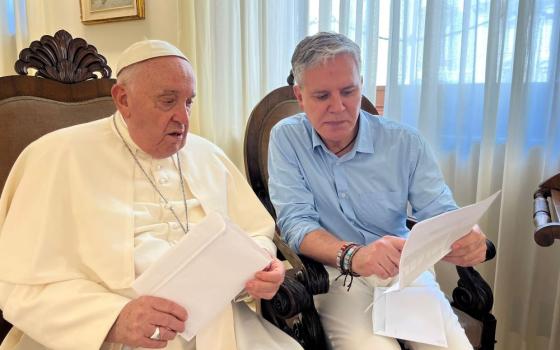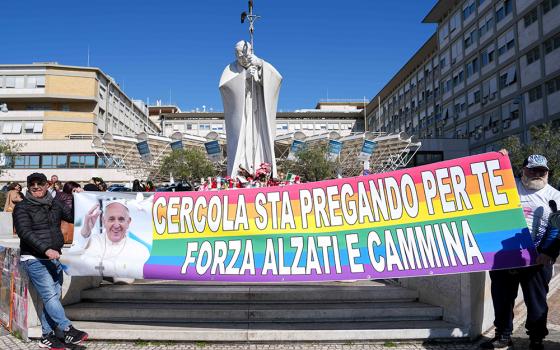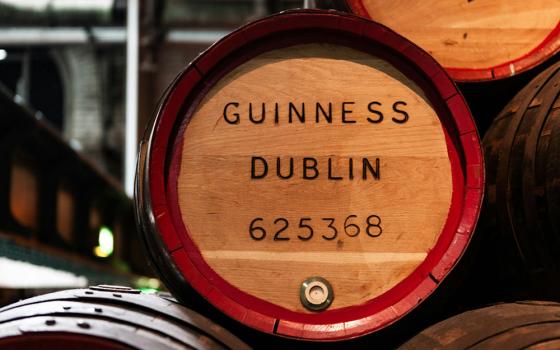
French President Emmanuel Macron visits the reconstruction site of the Notre-Dame cathedral Thursday, April 15, 2021 in Paris. Two years after a fire tore through Paris' most famous cathedral and shocked the world, French President Emmanuel Macron is visiting the building site that Notre Dame has become Thursday to show that French heritage has not been forgotten despite the coronavirus. (Benoit Tessier/Pool via AP)
Two years after a fire tore through Paris' most famous cathedral and shocked the world, French President Emmanuel Macron on April 15 visited the building site that Notre Dame has become to show that French heritage has not been forgotten despite the pandemic.
Flanked by ministers, architects and the retired French army general who is overseeing the restoration of the 12th-century monument, Macron viewed the progress of the ambitious rebuilding project. He offered the pandemic-weary French public hope that a completion date will arrive one day, if not in the near future.
"We're seeing here how, in two years, a huge job has been accomplished," Macron said, recalling the "emotion" throughout France at the images of flames devouring Notre Dame on April 15, 2019. "We also see what remains to be done."
Macron has promised that the cathedral would be rebuilt by 2024, yet officials acknowledge the work won't be fully completed by then. They cite factors such as the COVID-19 pandemic for having slowed down the pace of reconstruction. The blaze also distributed vast amounts of toxic lead onto Notre Dame and the surrounding area, complicating the clean-up work that came before restoration efforts could even begin.
The French president offered a "huge thank you" and a message of determination to all the workers mobilized to rebuild Notre Dame.
"We will need to meet our goals" set for three years from now, Macron said.
Cranes and scaffolding from the massive project scar the French capital's skyline, and the rebuilding work could take decades. Officials said this month that the burned-out cathedral and its esplanade could remain under construction for another 15 or 20 years. But they pledge that Notre Dame will be at least be open for prayer and a "return to worship" in time for the 2024 Summer Olympics, which Paris is hosting.
"The objective...is to return Notre Dame to worshippers and to visits in 2024. That means that in 2024, Mass will be able to be organized in the cathedral," Jeremie Patrier-Leitus, a spokesperson for the restoration, told The Associated Press.
Patrier-Leitus wants the world to know that "Notre Dame is holding up. It is still there. We are all gathered and mobilized to restore the cathedral and give this jewel of French Gothic architecture back to the world."

Workers stand on a scaffolding at the Notre-Dame cathedral, Thursday, April 15, 2021 in Paris. (Benoit Tessier/Pool via AP)
It remains to be seen if the cathedral will be in shape by then to welcome the 20 million tourists it received each year before the fire.
Since 2019, religious ceremonies have taken place at Notre Dame's temporary liturgical base at the nearby church of Saint-Germain l'Auxerrois. The church lacks the size and wow-factor that drew the faithful to the cathedral for nearly 900 years.
The Elysee presidential palace said Macron's visit "will be an opportunity for the head of state to thank again all those who helped save the cathedral from the flames" and after. That includes the carpenters, scaffolders, rope access technicians, crane operators, organ builders, master glassmakers, painting and sculpture restorers, stonemasons, archaeologists, researchers and donors who helped keep the restoration work going despite the difficulties posed by the current health crisis.
Two years is a blink of an eye in a restoration timeline. The Notre Dame project still in the initial consolidation phase. The actual restoration phase is expected to start next winter. But the overwhelming feeling among those who love Notre Dame is relief that the project so far has been a success.
"I can say today that the cathedral is saved. It is well secured and we can now do the huge work of reconstruction that is not going to destabilize the whole building," Notre Dame's rector, Patrick Chauvet, told the AP.
The consolidation phase costing 165 million euros ($197 million) was vital: 40,000 metal tubes from scaffolding in place at the time of the fire melted during the blaze and had to be patiently cut off the roof. The vaults inside the cathedral also had to be stabilized. In a sign of the work to come, though, 1,000 oak trees were felled in some 200 French forests this spring to make the frame for the cathedral's transept and spire — destined to be admired on the Paris skyline for centuries to come.
The night of the fire may well be 24 months ago, but it still feels very near to Parisian witnesses. Frederico Benani, who filmed the burning cathedral, was tearful as he recounted the experience.
"I was here with my wife having tea. I saw a little black flame and I never thought it was Notre Dame that was burning. And it was shocking for me to see all of those flames," Benani said. "It was horrible. It was sad. It breaks my heart."
___
Adamson reported from Leeds, England
Advertisement






